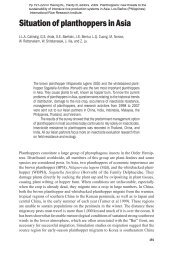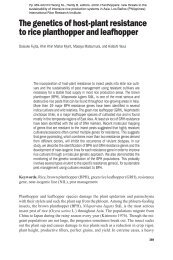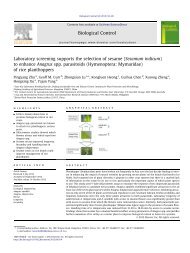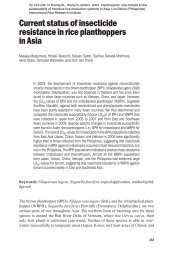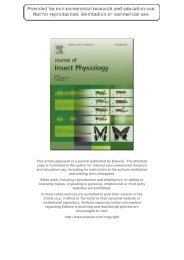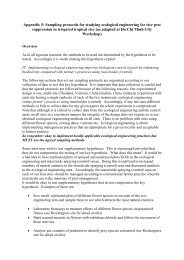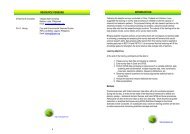Brain nicotinic acetylcholine receptors: native ... - Ricehoppers
Brain nicotinic acetylcholine receptors: native ... - Ricehoppers
Brain nicotinic acetylcholine receptors: native ... - Ricehoppers
You also want an ePaper? Increase the reach of your titles
YUMPU automatically turns print PDFs into web optimized ePapers that Google loves.
Review TRENDS in Pharmacological Sciences Vol.27 No.9 491<br />
57 Vailati, S. et al. (1999) Functional a6-containing <strong>nicotinic</strong> <strong>receptors</strong> are<br />
present in chick retina. Mol. Pharmacol. 56, 11–19<br />
58 Xiao, Y. et al. (2004) Pharmacology of the agonist binding sites of rat<br />
neuronal <strong>nicotinic</strong> receptor subtypes expressed in HEK 293 cells.<br />
Bioorg. Med. Chem. Lett. 14, 1845–1848<br />
59 Gotti, C. et al. (1994) Pharmacology and biophysical properties of a7<br />
and a7-a8 a-bungarotoxin receptor subtypes immunopurified from the<br />
chick optic lobe. Eur. J. Neurosci. 6, 1281–1291<br />
60 Gotti, C. et al. (1997) a7 and a8 <strong>nicotinic</strong> receptor subtypes<br />
immunopurified from chick retina have different immunological,<br />
pharmacological and functional properties. Eur. J. Neurosci. 9,<br />
1201–1211<br />
61 Gerzanich, V. et al. (1994) Homomers of a8 and a7 subunits of <strong>nicotinic</strong><br />
<strong>receptors</strong> exhibit similar channel but contrasting binding site<br />
properties. Mol. Pharmacol. 45, 212–220<br />
62 Rousseau, S.J. et al. (2005) Presynaptic a7 and non-a7 <strong>nicotinic</strong><br />
<strong>acetylcholine</strong> <strong>receptors</strong> modulate [ 3 H]D-aspartate release from rat<br />
frontal cortex in vitro. Neuropharmacology 49, 59–72<br />
63 Loffler, M. et al. (2006) Dopamine release in human neocortical slices:<br />
characterization of inhibitory auto<strong>receptors</strong> and of <strong>nicotinic</strong><br />
<strong>acetylcholine</strong> receptor-evoked release. <strong>Brain</strong> Res. Bull. 68, 361–373<br />
64 Cao, Y.J. et al. (2005) Different <strong>nicotinic</strong> <strong>acetylcholine</strong> receptor<br />
subtypes mediating striatal and prefrontal cortical [ 3 H]dopamine<br />
release. Neuropharmacology 48, 72–79<br />
65 Cao, Y.J. et al. (2005) Nicotinic <strong>acetylcholine</strong> receptor-mediated<br />
[ 3 H]dopamine release from hippocampus. J. Pharmacol. Exp. Ther.<br />
312, 1298–1304<br />
66 O’Leary, K.T. and Leslie, F.M. (2006) Enhanced <strong>nicotinic</strong> <strong>acetylcholine</strong><br />
receptor-mediated [ 3 H]norepinephrine release from neonatal rat<br />
hypothalamus. Neuropharmacology 50, 81–88<br />
67 Grady, S.R. et al. (2002) Characterization of <strong>nicotinic</strong> agonist-induced<br />
[ 3 H]dopamine release from synaptosomes prepared from four mouse<br />
brain regions. J. Pharmacol. Exp. Ther. 301, 651–660<br />
68 Endo, T. et al. (2005) Nicotinic <strong>acetylcholine</strong> receptor subtypes involved<br />
in facilitation of GABAergic inhibition in mouse superficial superior<br />
colliculus. J. Neurophysiol. 94, 3893–3902<br />
69 Salminen, O. et al. (2004) Subunit composition and pharmacology of<br />
two classes of striatal presynaptic <strong>nicotinic</strong> <strong>acetylcholine</strong> <strong>receptors</strong><br />
mediating dopamine release in mice. Mol. Pharmacol. 65, 1526–<br />
1535<br />
70 Sanberg, P.R. et al. (1997) Nicotine for the treatment of Tourette’s<br />
syndrome. Pharmacol. Ther. 74, 21–25<br />
71 Poirier, M.F. et al. (2002) Prevalence of smoking in psychiatric patients.<br />
Prog. Neuropsychopharmacol. Biol. Psychiatry 26, 529–537<br />
72 Martin-Ruiz, C.M. et al. (2004) Molecular analysis of <strong>nicotinic</strong> receptor<br />
expression in autism. <strong>Brain</strong> Res. Mol. <strong>Brain</strong> Res. 123, 81–90<br />
73 Lee, M. et al. (2002) Nicotinic receptor abnormalities in the cerebellar<br />
cortex in autism. <strong>Brain</strong> 125, 1483–1495<br />
74 Breese, C.R. et al. (2000) Abnormal regulation of high affinity <strong>nicotinic</strong><br />
<strong>receptors</strong> in subjects with schizophrenia. Neuropsychopharmacology<br />
23, 351–364<br />
75 Leonard, S. et al. (1996) Nicotinic receptor function in schizophrenia.<br />
Schizophr. Bull. 22, 431–445<br />
76 Martin-Ruiz, C.M. et al. (2003) Dementia rating and <strong>nicotinic</strong> receptor<br />
expression in the prefrontal cortex in schizophrenia. Biol. Psychiatry<br />
54, 1222–1233<br />
77 Levin, E.D. et al. (2006) Nicotinic effects on cognitive function:<br />
behavioral characterization, pharmacological specification, and<br />
anatomic localization. Psychopharmacology 184, 523–539<br />
78 Newhouse, P. et al. (2004) Nicotine and <strong>nicotinic</strong> receptor involvement<br />
in neuropsychiatric disorders. Curr. Top. Med. Chem. 4, 267–282<br />
79 Shytle, R.D. et al. (2002) Nicotinic <strong>acetylcholine</strong> <strong>receptors</strong> as targets for<br />
antidepressants. Mol. Psychiatry 7, 525–535<br />
80 Shytle, R.D. et al. (2002) Neuronal <strong>nicotinic</strong> receptor inhibition for<br />
treating mood disorders: preliminary controlled evidence with<br />
mecamylamine. Depress. Anxiety 16, 89–92<br />
81 Quik, M. (2004) Smoking, nicotine and Parkinson’s disease. Trends<br />
Neurosci. 27, 561–568<br />
82 Burghaus, L. et al. (2003) Loss of <strong>nicotinic</strong> <strong>acetylcholine</strong> receptor<br />
subunits a4 and a7 in the cerebral cortex of Parkinson patients.<br />
Parkinsonism Relat. Disord. 9, 243–246<br />
83 Kelton, M.C. et al. (2000) The effects of nicotine on Parkinson’s disease.<br />
<strong>Brain</strong> Cogn. 43, 274–282<br />
84 Court, J.A. et al. (2000) Nicotine binding in human striatum: elevation<br />
in schizophrenia and reductions in dementia with Lewy bodies,<br />
Parkinson’s disease and Alzheimer’s disease and in relation to<br />
neuroleptic medication. Neuroscience 98, 79–87<br />
85 Court, J. et al. (2001) Nicotinic receptor abnormalities in Alzheimer’s<br />
disease. Biol. Psychiatry 49, 175–184<br />
86 Perry, E.K. et al. (2001) Cholinergic activity in autism: abnormalities in<br />
the cerebral cortex and basal forebrain. Am. J. Psychiatry 158, 1058–<br />
1066<br />
87 Teaktong, T. et al. (2003) Alzheimer’s disease is associated with a<br />
selective increase in a7 <strong>nicotinic</strong> <strong>acetylcholine</strong> receptor<br />
immunoreactivity in astrocytes. Glia 41, 207–211<br />
88 Gotti, C. et al. (2006) <strong>Brain</strong> <strong>acetylcholine</strong> <strong>receptors</strong>. In The <strong>Brain</strong><br />
Cholinergic System (Giacobini, E. and Pepeu, G., eds), pp. 141–157,<br />
Informa Healthcare<br />
AGORA initiative provides free agriculture journals to<br />
developing countries<br />
The Health Internetwork Access to Research Initiative (HINARI) of the WHO has launched a new<br />
community scheme with the UN Food and Agriculture Organization.<br />
As part of this enterprise, Elsevier has given hundreds of journals to Access to Global Online<br />
Research in Agriculture (AGORA). More than 100 institutions are now registered for the scheme,<br />
which aims to provide developing countries with free access to vital research that will ultimately<br />
help increase crop yields and encourage agricultural self-sufficiency.<br />
According to the Africa University in Zimbabwe, AGORA has been welcomed by both students<br />
and staff. ‘‘It has brought a wealth of information to our fingertips’’, says Vimbai Hungwe. ‘‘The<br />
information made available goes a long way in helping the learning, teaching and research<br />
activities within the University. Given the economic hardships we are going through, it couldn’t<br />
have come at a better time.’’<br />
For more information, visit www.aginternetwork.org<br />
www.sciencedirect.com



